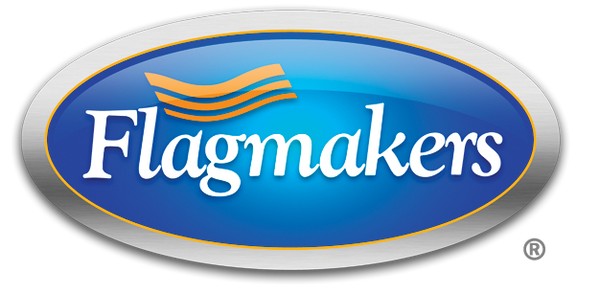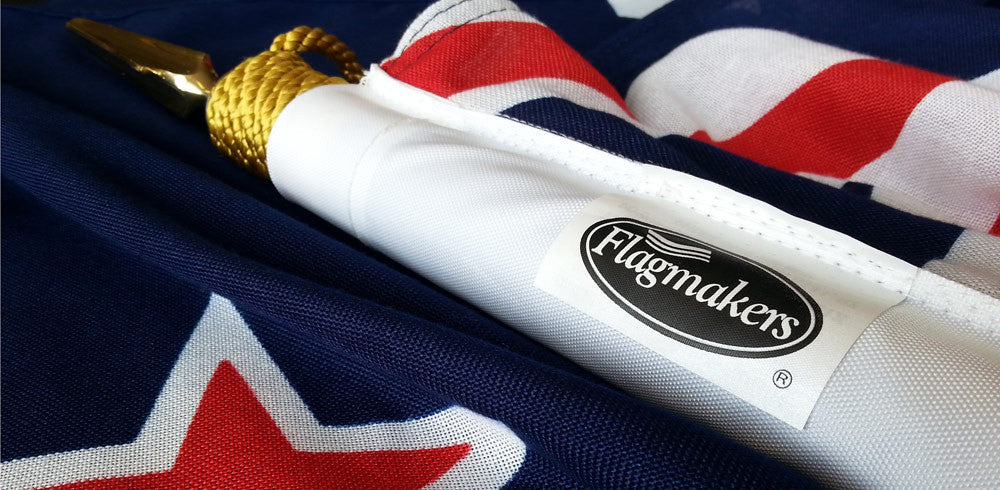The What, When and How
You can buy the New Zealand Flag from our online store, directly from our showroom in Wellington or by simply emailing us: sales@flagmakers.co.nz.
When looking at buying the NZ Flag there are a few things to consider:
- If just for interior display, then a standard flag will do. You can hang it vertically using a pole sleeved though the header. Most people prefer to leave the ropes and swivel clips or toggles on so that is still looks like an authentic flag.
- If you are in a windy location then the 'Polybunting' fabric is suitable as it requires more wind strength to fly it. The Polybunting flag is a woven polyester material. It has that traditional look and feel too.
In less windier conditions, the Polyknit fabric is more suitable as it is a lighter fabric. - Both fabrics are equally durable and made of polyester; one is knitted and one is woven. The woven fabric gives that traditional look and feel and it is more suitable to fly in windier locations.
- Look for authenticity of colours. The NZ flag, like all other national flags have strict specifications on their colours - called PMS colours. At Flagmakers, we guarantee colour accuracy to international standards
- The quality of the finishing is very important if you want your flag to last. Most imported flags are made of thinner materials and are not sewn in a manner that ensures the flag will last in windy conditions.
Rules and Protocols
When flying the NZ Flag there are a few rules as it is the national symbol of New Zealand. According to the Ministry of Culture and Heritage:
"To destroy or damage the Flag in a public place with the intention of dishonouring it is an offence- as is the placement of any letter, emblem or representation on the Flag.
Individuals and organisations may use the New Zealand Flag in advertising. Letters or designs should not be added to the Flag unless they are clearly separate to the Flag design. If you want to use the New Zealand Flag in advertisements or for commercial purposes, contact us to discuss your ideas."
Other important information from the Ministry of Culture and Heritage site:
The New Zealand Flag can be flown any day of the year, usually during working hours, and in a variety of places. Flag flying can be observed on a 24 hour basis especially when buildings are floodlit – although continuous flying shortens a flag’s life and it may have to be replaced more often. The New Zealand Flag should never be flown in a dilapidated condition.
Days of national commemoration
Flag flying is particularly encouraged on the following days, which are designated days of national commemoration:
February
6 - Accession of Her Majesty The Queen and Waitangi Day
March
2nd Monday - Commonwealth Day
April
21 - Birthday (actual) of Her Majesty The Queen
25 - Anzac Day*
June
First Monday - Official birthday of Her Majesty The Queen
2 - Coronation Day
10 - Birthday of His Royal Highness The Duke of Edinburgh
October
24 - United Nations Day
4th Monday - Labour Day
November
14 - Birthday of His Royal Highness The Prince of Wales
*Anzac Day is New Zealand's national day for commemorating those who have served this country in times of war, and the New Zealand Flag should be flown at the top of the flagpole. However, at places where commemorative services are held, it is appropriate for the flag to be lowered to half-mast for the duration of a memorial service as a sign of respect.
Other official occasions
The New Zealand Flag should be flown to mark:
- the opening of Parliament (Wellington only) by The Queen or the Governor-General
- the swearing-in ceremony of the Governor-General designate and the state farewell for the outgoing Governor-General (Wellington only)
- visits by the Royal Family and other distinguished people such as a Head of State or Head of Government (only in the city or area being visited
- other special occasions, such as a royal birth, subject to special command by the Governor-General or direction of the Prime Minister.
Times of mourning
Flags are flown at half-mast as a sign of mourning.
The flag is half-masted by raising it to the top of the mast, then slowly lowering it to the half-mast position, which will depend on the size of the flag and the length of the flagpole.
The flag must be lowered to a position more than its own depth from the top of the flagpole to avoid the appearance of a flag which has accidentally fallen from the top of the flagpole. When the New Zealand Flag is flown at half-mast, other flags should not be flown above it. The Flag should be raised again to the peak before lowering it for the day.
Flags on government buildings should be flown at half-mast when directed by the Chief Executive of the Ministry for Culture and Heritage.
For government and public buildings, flags should be flown at half-mast during times of mourning for the following people and according to the following procedures.
The Sovereign
From the announcement of death up to and including the day of the funeral (except on Proclamation Day when the new sovereign is officially announced and flags are flown from the top of the mast).
- The Governor-General, former Governors-General, the Prime Minister and former Prime Ministers
- On the announcement of death and the day of the funeral
- Members of the Royal Family
- On the day of the funeral subject to special command from The Queen or the Governor-General.
- Commonwealth Governors-General, Commonwealth Prime Ministers in office, Foreign and Commonwealth Heads of State
- On the day of the funeral only.
- When local authorities fly their local flag at half-mast following the death of a prominent local citizen, it is appropriate to do so on the day or part of the day of the funeral. The same etiquette applies to the house flag of a company or organisation. In these cases the New Zealand Flag should remain at full mast.
Government buildings
For government buildings with flagpoles, the New Zealand Flag should be flown every day during normal weekday working hours and only in the weekend if the building is in use.
Diplomatic posts
New Zealand’s diplomatic posts overseas, including the residences of Heads of Mission, should fly the New Zealand Flag daily.
Naval ships and Government vessels
Commissioned ships of the Royal New Zealand Navy fly the New Zealand Flag as a jack (at the bow) when anchored, secured to a buoy, moored, or tied to a wharf. They also fly the New Zealand White Ensign at the stern. Government vessels fly the New Zealand Flag as an ensign (at the stern).
Merchant ships and pleasure craft
New Zealand registered merchant ships, pleasure boats and yachts may fly the New Zealand Red Ensign.
Aircraft
Both the New Zealand Flag and the New Zealand Civil Air Ensign may be flown on aircraft registered inNew Zealand. Airlines owning New Zealand aircraft, and the Civil Aviation Authority, may fly the Ensign on their buildings as well as on their aircraft.

